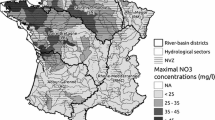Abstract
The performance of different policy design strategies is a key issue in evaluating programmes for water quality improvement under the Water Framework Directive (60/2000). This issue is emphasised by information asymmetries between regulator and agents. Using an economic model under asymmetric information, the aim of this paper is to compare the cost-effectiveness of selected methods of designing payments to farmers in order to reduce nitrogen pollution in agriculture. A principal-agent model is used, based on profit functions generated through farm-level linear programming. This allows a comparison of flat rate payments and a menu of contracts developed through mechanism design. The model is tested in an area of Emilia Romagna (Italy) in two policy contexts: Agenda 2000 and the 2003 Common Agricultural Policy (CAP) reform. The results show that different policy design options lead to differences in policy costs as great as 200–400%, with clear advantages for the menu of contracts. However, different policy scenarios may strongly affect such differences. Hence, the paper calls for greater attention to the interplay between CAP scenarios and water quality measures.
Similar content being viewed by others
References
Bazzani GM, Ragazzoni A, Viaggi D (2000) Application of agri-environmental programs in Emilia Romagna Region. In Canavari P, Caggiati M, Easter KW (eds) Economic studies on food, agriculture and the environment. Kluwer Academic/Plenum Publishers, New York pp 339–353
Bontems P, Thomas A (2006) Regulating nitrogen pollution with risk adverse farmers under hidden information and moral hazard. American Journal of Agricultural Economics 88(1):57–72
Bontems P, Rotillon G, Turpin N (2004) Improvement of water quality as joint production of milk when dairy farms are heterogeneous, In 90th EAAE seminar Multifunctional Agriculture, Policies and Markets: Understanding the Critical Linkages, 28–29 October 2004, Rennes, pp 219–227
Bontems P, Rotillon G, Turpin N (2005) Self-selecting agri-environmental policies with an application to the Don watershed. Environmental and Resource Economics 31:275–301
Emilia Romagna Region (2003). Relazione sullo stato di attuazione del piano regionale di sviluppo rurale 2000–2006 in Emilia Romagna. Annualità 2002. Bologna
European Environmental Agency (2005) IRENA Indicator fact sheets, http://www.eea.eionet.eu.int/Public/irc/eionet-circle/irena/
Fraser I (1993) Agri-environmental policy and discretionary incentive mechanism: the countryside stewardship scheme as a case study. Manchester Metropolitan University. Department of Economics and Economic History, Manchester
Gren IM (2004) Uniform or discriminating payments for environmental production on arable land under asymmetric information. European Review of Agricultural Economics 31:61–76
Havlik P, Jacquette F, Boisson JM (2003) Agri-environmental agreements for enhancing biodiversity production by farmers in Bile Karpaty, Czech Republic: An empirical analysis of agency theory application. 81st EAAE Seminar. Copenhagen
Laffont JJ, Martimort D (2002) The theory of incentives. The principal-agent model. Princeton University Press, Princeton
Laffont JJ, Tirole J (1993) The theory of incentives in procurement and regulation. MIT Press, Cambridge, MA
Latacz-Lohmann, U. 2004. Dealing with limited information in design and evaluating agri-environmental policy. In 90th EAAE Seminar Multifunctional Agriculture, Policies and Markets: Understanding the Critical Linkages, October 2004, Rennes, pp 33–50
Latacz-Lohmann U, Van der Hamsvoort C (1997) Auctioning conservation contracts: a theoretical analysis and an application. American Journal of Agricultural Economics 79:407–418
Latacz-Lohmann U, Van der Hamsvoort C (1998) Auctions as a means of creating a market for public goods from agriculture. Journal of Agricultural Economics 49:334–345
Moxey A, White B, Ozanne A (1999) Efficient contract design for agri-environmental policy. Journal of Agricultural Economics 50:187–202
Mzoughi N, Déprés C, Grolleau G (2005) Contracting for environmental property rights: the case of Vittel, XIth Congress of the European Association of Agricultural Economists, Copenhagen, 24–27 August 2005
Richard A, Trommeter M (1994) The rationalization of contracts between public sector and farmer: The case of agri-environmental measures. In Aubert D (ed) Reforming the common agricultural policy: The contribution of economic research. INRA-Editions, Paris, pp 307–323
Salanié B (1998) The economics of contracts. A primer. MIT Press, Cambridge: MA
Shortle JS, Abler D (eds) (2001) Environmental Policies for Agriculture Pollution Control. CABI Publishing, Wallingford
Shortle JS, Horan RD (2001) The economics of nonpoint pollution control, Journal of Economic Surveys 15(3):255–289
Turpin N, Rotillon G, Bontems P, Bioteau T, Laplana R (2003) Mitigating non point source pollution from dairy farms: economic evaluation on the Don watershed. In 12th Nitrogen Workshop, Controlling Nitrogen Flows and Losses, Exeter, 24–26 September 2003, pp 54–62
WATECO (2003) Common implementation strategy for the Water Framework Directive (2000/60/EC). European Commission. Brussels
Wu J (2000) Input substitution and pollution control under uncertainty and firm heterogeneity, Journal of Public Economic Theory 2(2):273–288
Wu J, Babcock BA (1996) Contract design for the purchase of environmental goods from agriculture, American Journal of Agricultural Economics 78(4):935–945
Xepapadeas AP (1997) Advanced principles in environmental policy. Edward Elgar, Cheltenham
Xepapadeas AP (2004) Environmental policy under imperfect information: incentives and moral hazard. The Economics of Agri-Environmental Policy 1:267–280
Acknowledgments
The work is based on the outcome of the research “Strumenti di valorizzazione economica della multifunzionalità dell’agricoltura,” funded by the Emilia Romagna Region, L.R. 28. The authors wish to thank the anonymous referees for their useful comments. The responsibility for the paper, of course, remains that of the authors.
Author information
Authors and Affiliations
Corresponding author
Rights and permissions
About this article
Cite this article
Bartolini, F., Gallerani, V., Raggi, M. et al. Implementing the Water Framework Directive: Contract Design and the Cost of Measures to Reduce Nitrogen Pollution from Agriculture. Environmental Management 40, 567–577 (2007). https://doi.org/10.1007/s00267-005-0136-z
Received:
Accepted:
Published:
Issue Date:
DOI: https://doi.org/10.1007/s00267-005-0136-z




